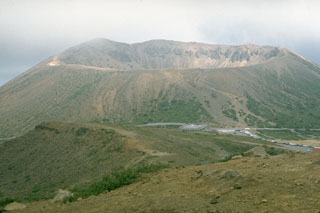Report on Azumayama (Japan) — May 1996
Bulletin of the Global Volcanism Network, vol. 21, no. 5 (May 1996)
Managing Editor: Richard Wunderman.
Azumayama (Japan) Small-amplitude volcanic tremor
Please cite this report as:
Global Volcanism Program, 1996. Report on Azumayama (Japan) (Wunderman, R., ed.). Bulletin of the Global Volcanism Network, 21:5. Smithsonian Institution. https://doi.org/10.5479/si.GVP.BGVN199605-283180
Azumayama
Japan
37.735°N, 140.244°E; summit elev. 1949 m
All times are local (unless otherwise noted)
Small-amplitude volcanic tremors were detected on 26 April and 26 May. The last eruption occurred in December 1977. Earthquakes began in September 1977, followed by mud and sand spattering and ejection of small blocks in October, and active fuming in November. The small eruption on 7 December 1977 sent ash 500-1,000 m above the crater and produced minor ashfall. Similar ash ejections occurred through January 1978 (SEAN 03:01 and 03:02).
Geological Summary. The Azumayama volcanic group consists of a cluster of stratovolcanoes, shield volcanoes, lava domes, and pyroclastic cones. The andesitic and basaltic complex was constructed in two E-W rows above a relatively high basement of Tertiary sedimentary rocks and granodiorites west of Fukushima city. Volcanic activity has migrated to the east, with the Higashi-Azuma volcano group being the youngest. The symmetrical Azuma-Kofuji crater and a nearby fumarolic area on the flank of Issaikyo volcano are popular tourist destinations. The Azumayama complex contains several crater lakes, including Goshikinuma and Okenuma. Historical eruptions, mostly small phreatic explosions, have been restricted to Issaikyo volcano at the northern end of the Higashiyama group.
Information Contacts: Japan Meteorological Agency (JMA), Volcanological Division, Seismological and Volcanological Department, 1-3-4 Ote-machi, Chiyoda-ku, Tokyo 100, Japan.

